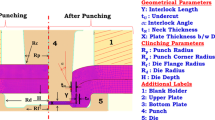Abstract
The influence of clinching tool design in joining metal sheets by the clinching process with extensible dies is investigated. The material flow during the clinching process was examined experimentally and numerically. The geometrical and mechanical characteristics of joints produced under different processing conditions, that is, forming loads, were used to calibrate and validate a 3D finite element model of the clinching process. Then, the model was utilized to evaluate the influence of clinching tool design parameters, namely the punch diameter, the punch corner radius, the fixed die depth, the fixed die diameter, and the die corner radius. The effects of design parameters on the cross section of a clinched joint, the required forming load and the joint strength were analysed and the appropriate processing window was determined. According to the achieved results, the main benefits and drawbacks of each configuration are discussed.
Similar content being viewed by others
References
Lee C-J, Kim J-Y, Lee S-K, Ko D-C, Kim B-M (2010) Parametric study on mechanical clinching process for joining aluminum alloy and high-strength steel sheets. J Mech Sci Technol 24:123–126
Chen YC, Nakata K (2009) Microstructural characterization and mechanical properties in friction stir welding of aluminum and titanium dissimilar alloys. Mater Des 30(3):469–474
Cao X, Jahazi M (2009) Effect of welding speed on the quality of friction stir welded butt joints of a magnesium alloy. Mater Des 30(6):2033–2042
Hamilton C, Dymek S, Sommers A (2008) A thermal model of friction stir welding in aluminum alloys. Int J Mach Tools Manuf 48(10):1120–1130
Zhang Z, Zhang HW (2007) Material behaviors and mechanical features in friction stir welding process. Int J Adv Manuf Technol 35(1–2):86–100
Fratini L, Ruisi VF (2008) Self-piercing riveting for aluminium alloys–composites hybrid joints. Int J Adv Manuf Technol 43(1–2):61–66
Settineri L, Atzeni E, Ippolito R (2010) Self piercing riveting for metal–polymer joints. Int J Mater For 3(S1):995–998
He X, Pearson I, Young K (2008) Self-pierce riveting for sheet materials: state of the art. J Mater Proc Technol 199(1–3):27–36
Lee C-J, Kim J-Y, Lee S-K, Ko D-C, Kim B-M (2010) Design of mechanical clinching tools for joining of aluminium alloy sheets. Mater Des 31(4):1854–1861
Oudjene M, Benayed L, Delameziere A, Batoz J (2009) Shape optimization of clinching tools using the response surface methodology with Moving Least-Square approximation. J Mater Proc Technol 209(1):289–296
Depaula A, Aguilar M, Pertence A, Cetlin P (2007) Finite element simulations of the clinch joining of metallic sheets. J Mater Proc Technol 182(1–3):352–357
Varis J (2006) Ensuring the integrity in clinching process. J Mat Proc Tech 174(1–3):277–285
Hamel V, Roelandt JM, Gacel JN, Schmit F (2000) Finite element modeling of clinch forming with automatic remeshing. Comp Stru 77:185–200
Varis JP (2003) The suitability of clinching as a joining method for high-strength structural steel. J Mater Proc Technol 132:242–249
Grujicic M, Sellappan V, Arakere G, Seyr N, Obieglo A, Erdmann M, Holzleitner J (2008) The potential of a clinch-lock polymer metal hybrid technology for use in load-bearing automotive components. J Mater Eng Perf 18(7):893–902
Pedreschi R, Sinha B (2008) An experimental study of cold formed steel trusses using mechanical clinching. Con Bui Mater 22(5):921–931
Mucha J (2011) The analysis of lock forming mechanism in the clinching joint. Mater Des 32(10):4943–4954
Abe Y, Mori K, Kato T (2012) Joining of high strength steel and aluminium alloy sheets by mechanical clinching with dies for control of metal flow. J Mater Proc Technol 212(4):884–889
He X, Gu F, Ball A (2011) Recent development in finite element analysis of self-piercing riveted joints. Int J Adv Manuf Technol 58(5–8):643–649
Neugebauer R, Kraus C, Dietrich S (2008) Advances in mechanical joining of magnesium. CIRP Annals - Manuf Tech 57(1):283–286
Pietrapertosa C, Zhang L, Habraken AM, Jaspart JP (2003) Clinching joining system: validation of numerical models. ESAFORM Conference on Material Forming, Salerno, 28–30 April
Author information
Authors and Affiliations
Corresponding author
Rights and permissions
About this article
Cite this article
Lambiase, F. Influence of process parameters in mechanical clinching with extensible dies. Int J Adv Manuf Technol 66, 2123–2131 (2013). https://doi.org/10.1007/s00170-012-4486-4
Received:
Accepted:
Published:
Issue Date:
DOI: https://doi.org/10.1007/s00170-012-4486-4



